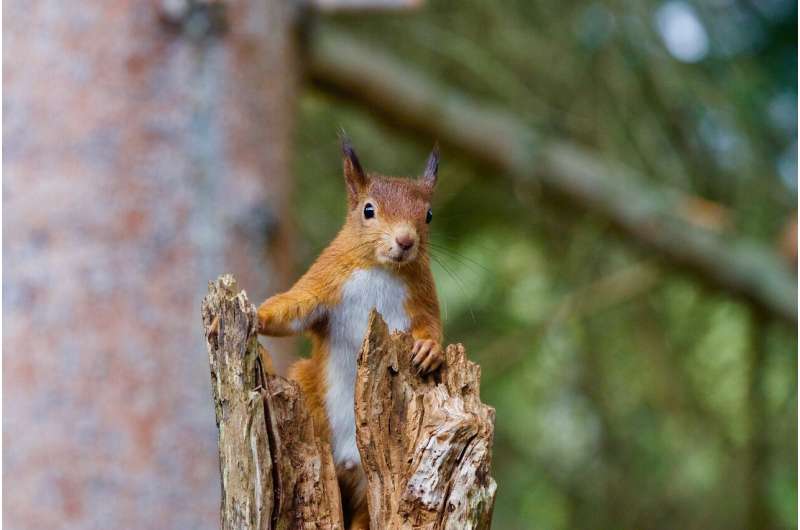This article has been reviewed according to Science X's editorial process and policies. Editors have highlighted the following attributes while ensuring the content's credibility:
fact-checked
proofread
Scientists are unraveling the secrets of red and gray squirrel competition

In a first of its kind study, researchers have identified significant differences between the diversity of gut bacteria in gray squirrels compared to red squirrels which could hold the key to further understanding the ability of gray squirrels to outcompete red squirrels in the UK.
New research, published in the Journal of Medical Microbiology, looked to understand more about the mechanisms by which gray squirrels are able to gain an advantage over red squirrels. Chris Nichols, Conservation Evidence Manager at the Woodland Trust, and co-author of the study, said,
"The more we know about gray squirrels, the more equipped we're going to be in the future to tackle the threats they pose to red squirrels and our native trees, which is one of the biggest problems for forest conservation in the UK."
Gray squirrels are an invasive, non-native species introduced from North America to sites in Great Britain and Ireland between 1876 and 1929. They outcompete the native red squirrels and multiply thanks to various traits including their ability to access a broader range of food sources including the bark of UK broadleaved trees. This causes significant damage to the trees and is a behavior that, prior to this research, was not completely understood.
To learn more about what gives gray squirrels an edge over red squirrels, researchers collaborating from the Woodland Trust, University of Surrey, University of Bangor and the Animal and Plant Health Agency analyzed the gut microbiota of the two species. The diversity and abundance of the microbes that make up the gut microbiota (microbes living within a particular environment—in this case the squirrel gut) is often an indicator of the diet, level of health and immunity of an individual.
Researchers sampled bacterial DNA from the gut contents of red and gray squirrels and performed DNA sequencing to identify the bacterial groups present in the two species. They then compared the results to identify any key differences.
They found significant differences in the diversity of gut bacteria between the two types of squirrels, with gray squirrels having a more diverse range of microbiota in their gut.
Lead author of the study Professor Roberto La Ragione, Professor of Veterinary Microbiology and Pathology at the University of Surrey, explained, "Red squirrels are now an endangered species in the UK. Not only are gray squirrels larger and more robust than red squirrels, we have now identified a significant difference in their gut bacterial microbiota, potentially giving them another advantage over reds."
This increased diversity in the gray squirrel gut microbiota could indicate improved general health and immunity compared to red squirrels. It could also reflect the gray squirrel's broader diet, but crucially the difference between the two sample groups provides researchers with valuable information on the way in which gray squirrels are able to access a broader range of resources.
Researchers also identified the presence of oxalate-degrading bacteria in the guts of gray squirrels which means it is likely that they can digest calcium from tree bark and may explain the destructive bark-stripping behavior of the gray squirrels.
As this research was a sample of only UK red squirrels researchers hope that future research could look to mapping the gut microbiota of other native red squirrel populations across Europe to understand more.
Chris Nichols is optimistic about the implications of these findings. "More research needs to be done to further understand the relationship between red and gray squirrels and their gut microbiota, but perhaps in the future we could develop this research into methods that could promote healthy gut bacteria in red squirrels or new ways of preventing squirrels from damaging trees."
Professor Ian Brown OBE, Animal and Plant Health Agency Director of Scientific Services, said, "These findings will help further our understanding of the impact gray squirrels have on the UK's red squirrel population and our vitally important trees and forests, which will in turn help us understand how best to protect them in the future."
More information: Significant differences in the caecal bacterial microbiota of red and grey squirrels in Britain, Journal of Medical Microbiology (2024). DOI: 10.1099/jmm.0.001793
Provided by Microbiology Society




















